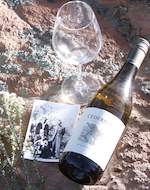Family tradition, love of the land, farmers at heart, pioneers in spirit; all these traits are part of a strong, if familially complicated and historically sometimes fraught Nieuwoudt legacy. But the Dwarsrivier inheritance seems to sit lightly on the strong shoulders of fifth-generation David. He clearly holds it dear.

It starts with the names. He bears those of his grandfather and great, great-grandfather David Josephus Nieuwoudt, who started farming Dwarsrivier in 1893 after the arrival of the first Nieuwoudts in this rugged, isolated wilderness area in the mid-1800s. Alternate generations carry the name, Ernst Hendrik.
On Dwarsrivier they farmed fruit, tobacco, vegetables, and livestock until grandfather Oom 'Pollie' planted table grapes in 1963, from which a bit of wine was made for home consumption. This was followed in 1973 by cabernet sauvignon and pinotage, so impressing the fundis that Cape Riesling (Crouchen Blanc) and sauvignon blanc soon followed.
David's uncle, Oom Flippie, eventually became winemaker, self-taught, and making do with a converted fruit packing shed until 1997, when David returned to the farm, qualified and ambitious. 'My dad was always more of a sheep man. But he bought Oom Flippie out and supported me all the way.
When we finally decided to take out all the fruit and plant vines, he just got up one morning and started sawing down the first pear trees, right there opposite the house.
My poor mom got a huge fright. It was a risk, but that's my dad. We get on very well. We’re quite different: he's quiet, thoughtful, cautious, but great with people.'
The risk lay more in the fact that there was no history of quality winemaking in the Cederberg. But David had scientifically soil-mapped some 60 hectares of the 5 500-hectare farm as high-potential viticultural land. By 2004, Dwarsrivier was commercially devoted solely to wine.
David knows the area like the back of his hand. He's a quick study and shows impatience with lingering misconceptions of the area as being too hot for wine.
'Cederberg is one of the coolest, most temperate wine wards in the Western Cape. We lie at the foot of the Sneeuberg, one of the Western Cape's three highest peaks, topping 2 000 metres. Our vineyards are between 900 and 1 100 metres, by far the highest in the Winelands. Day-night temperatures vary by 20-25°C.
The winter average is -4°C when frost lies like snow in the dormant vineyards. At this altitude, there is a gentle, cool wind during the summer ripening season. Our harvest can end as late as mid-April in some years!'
And that's why he can make the style of wine he most enjoys drinking, with minimal 'fiddling' in the cellar: 'Full of fruit, but fresh and vibrant.' And which is why he drinks more white: probably as much as 70 percent of the time.
Although Cederberg Private Cellar is probably most synonymous with sauvignon blanc and Shiraz when it comes to red David admits to being 'a cabernet man' and rates, without bias, Cederberg's Five Generations and the cabernets from Jonkershoek and high up on the Helderberg. These are all cooler areas so they ripen even later than normal and are naturally rich and elegant; real "Cab" cabs.'